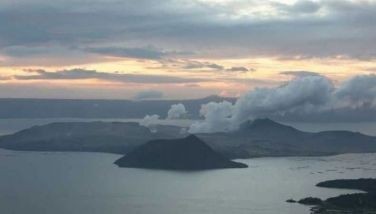Mayon unrest heightens
May 15, 2001 | 12:00am
Mayon Volcano has shown signs of heightened unrest in recent days with spurts of lava trickling down its slopes, but scientists said yesterday an eruption is not imminent.
During the 24-hour period ending at 8 a.m. yesterday, seismic stations on the volcano’s southern slope detected ground vibrations caused by rocks rolling out of the lava dome and tremors associated with lava movement, the Philippine Institute of Volcanology and Seismology (Phivolcs) said.
The institute reported that a partial collapse of the lava dome produced a V-shaped gash on it, pushing lava 500 meters down the slopes of the 2,474-meter volcano, about 330 kilometers southeast of Manila.
Scientists are maintaining alert level 3 around the volcano, an indicator that eruptions "may occur within the following weeks." The alert system has five stages.
"This assessment may change in view of heightened unrest since the past days," the institute said.
The volcanology institute said if the rate at which the dome is fracturing increase, lava trickles or fountaining and pyroclastic flows, which are superheated clouds of volcanic gas and ash, could be produced.
Volcanologist Alex Baloloy said they are anticipating "a possible faster intrusion rate once the lava dome presently clogging the crater totally collapses."
Col. Dante Bonifacio, commander of the 202nd Infantry Brigade, said members of Task Force Mayon are on 24-hour alert to evacuate 17,155 residents of 63 barangays in the towns of Malilipot, Guinobatan, Camalig and Daraga and the cities of Legazpi and Ligao, once the alert level is raised to 4.
The volcano last erupted in February 2000, driving 68,000 people from their homes. A six-kilometer area around Mayon is declared permanently off-limits.
Mayon’s most violent eruption, in 1814, killed more than 1,200 people and buried the entire town of Cagsawa in volcanic mud.  Felix de los Santos, Cet Dematera and Celso Amo
During the 24-hour period ending at 8 a.m. yesterday, seismic stations on the volcano’s southern slope detected ground vibrations caused by rocks rolling out of the lava dome and tremors associated with lava movement, the Philippine Institute of Volcanology and Seismology (Phivolcs) said.
The institute reported that a partial collapse of the lava dome produced a V-shaped gash on it, pushing lava 500 meters down the slopes of the 2,474-meter volcano, about 330 kilometers southeast of Manila.
Scientists are maintaining alert level 3 around the volcano, an indicator that eruptions "may occur within the following weeks." The alert system has five stages.
"This assessment may change in view of heightened unrest since the past days," the institute said.
The volcanology institute said if the rate at which the dome is fracturing increase, lava trickles or fountaining and pyroclastic flows, which are superheated clouds of volcanic gas and ash, could be produced.
Volcanologist Alex Baloloy said they are anticipating "a possible faster intrusion rate once the lava dome presently clogging the crater totally collapses."
Col. Dante Bonifacio, commander of the 202nd Infantry Brigade, said members of Task Force Mayon are on 24-hour alert to evacuate 17,155 residents of 63 barangays in the towns of Malilipot, Guinobatan, Camalig and Daraga and the cities of Legazpi and Ligao, once the alert level is raised to 4.
The volcano last erupted in February 2000, driving 68,000 people from their homes. A six-kilometer area around Mayon is declared permanently off-limits.
Mayon’s most violent eruption, in 1814, killed more than 1,200 people and buried the entire town of Cagsawa in volcanic mud.  Felix de los Santos, Cet Dematera and Celso Amo
BrandSpace Articles
<
>
- Latest
- Trending
Trending
Latest
Trending
Latest
Recommended
































